Controlling contention window to ensure QoS for multimedia data in wireless network
Abstract: The IEEE-802.11e standard was published with the goal of ensuring quality of service, especially with multimedia data. However, this standard only assigns different priorities for different types of data but does not control the sharing of bandwidth among different data flows. In this paper, we will propose a method of sharing bandwidth for proportional data flows and controlling Contention Window of each priority flow to achieve that ratio
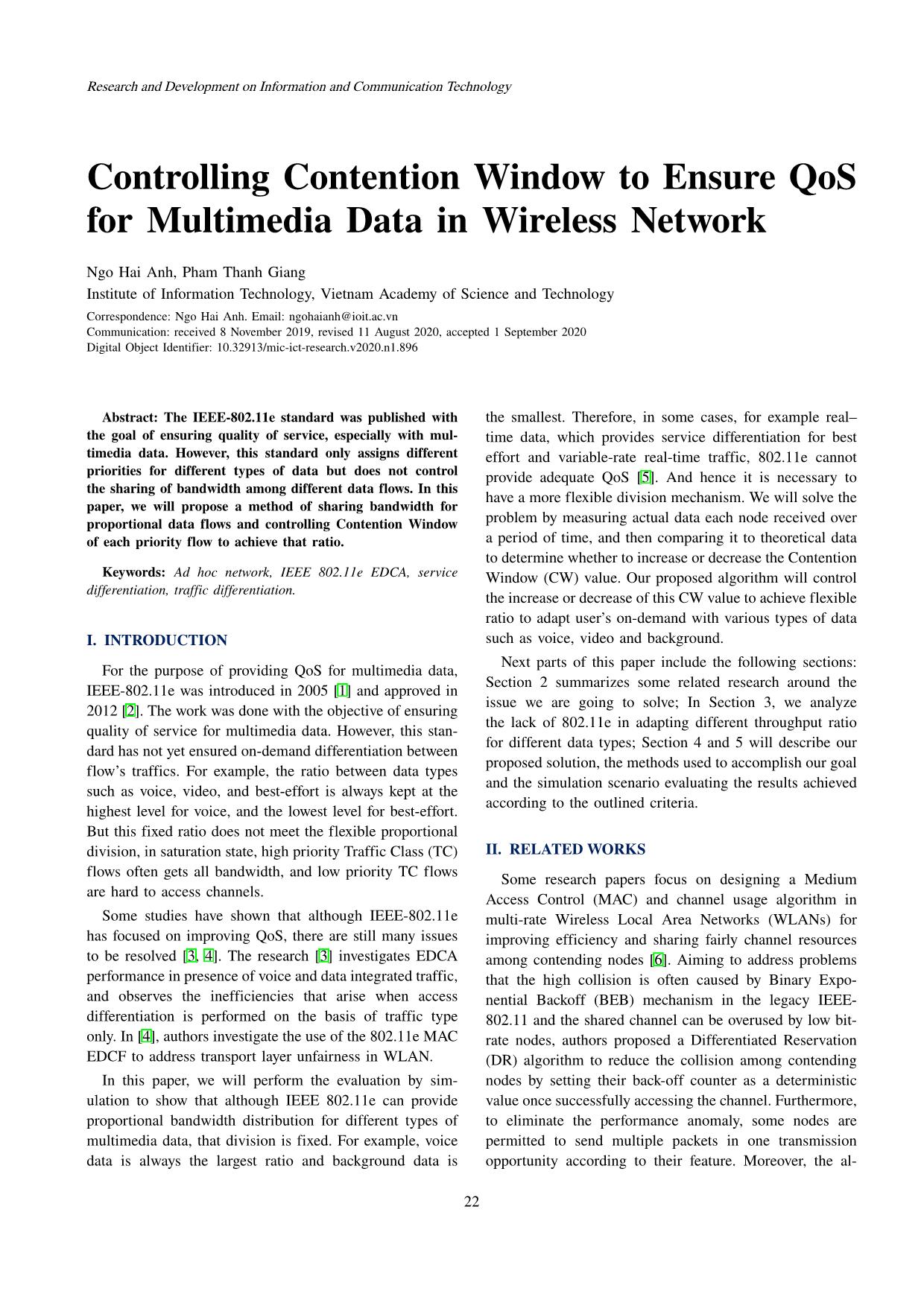
Trang 1
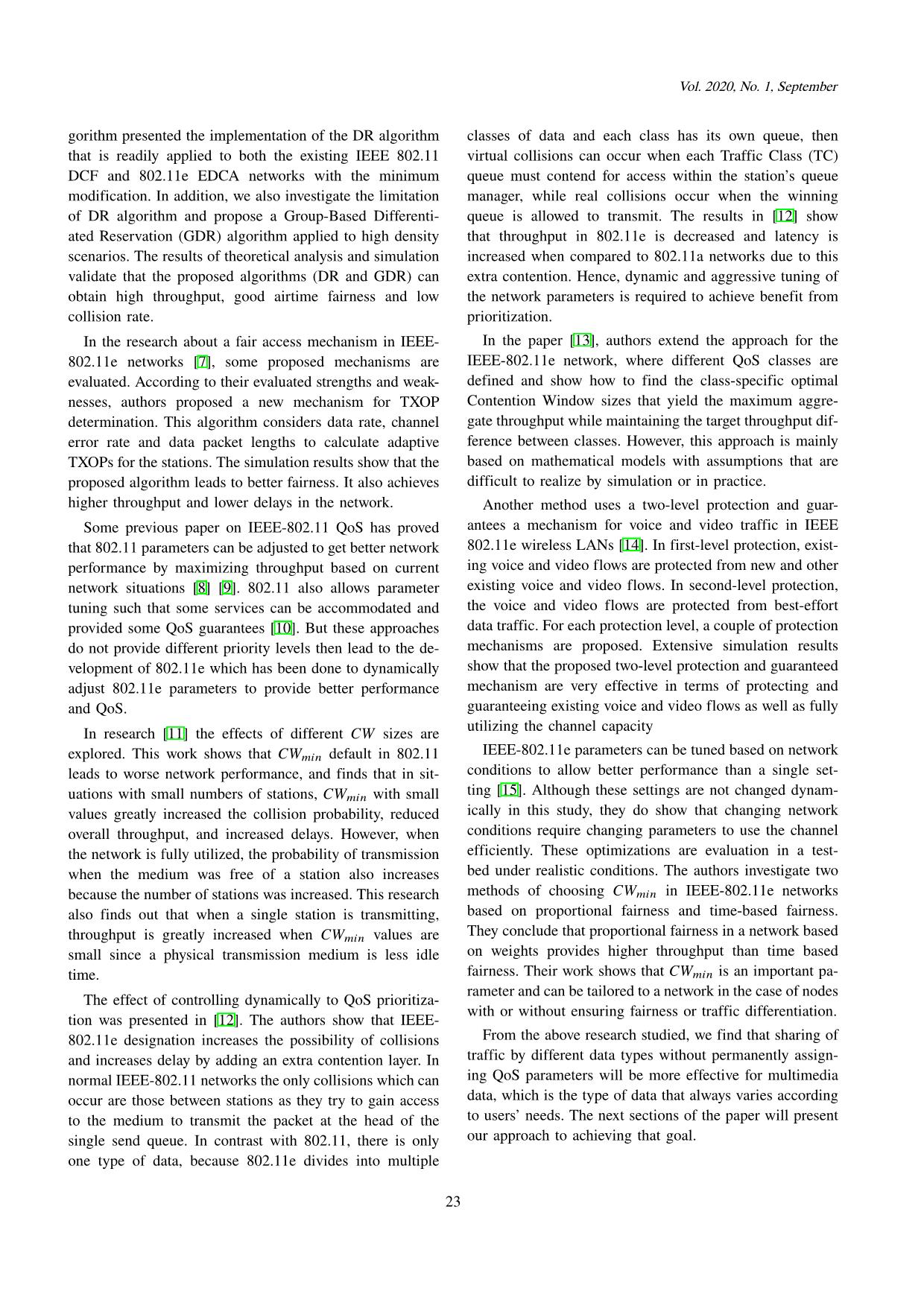
Trang 2
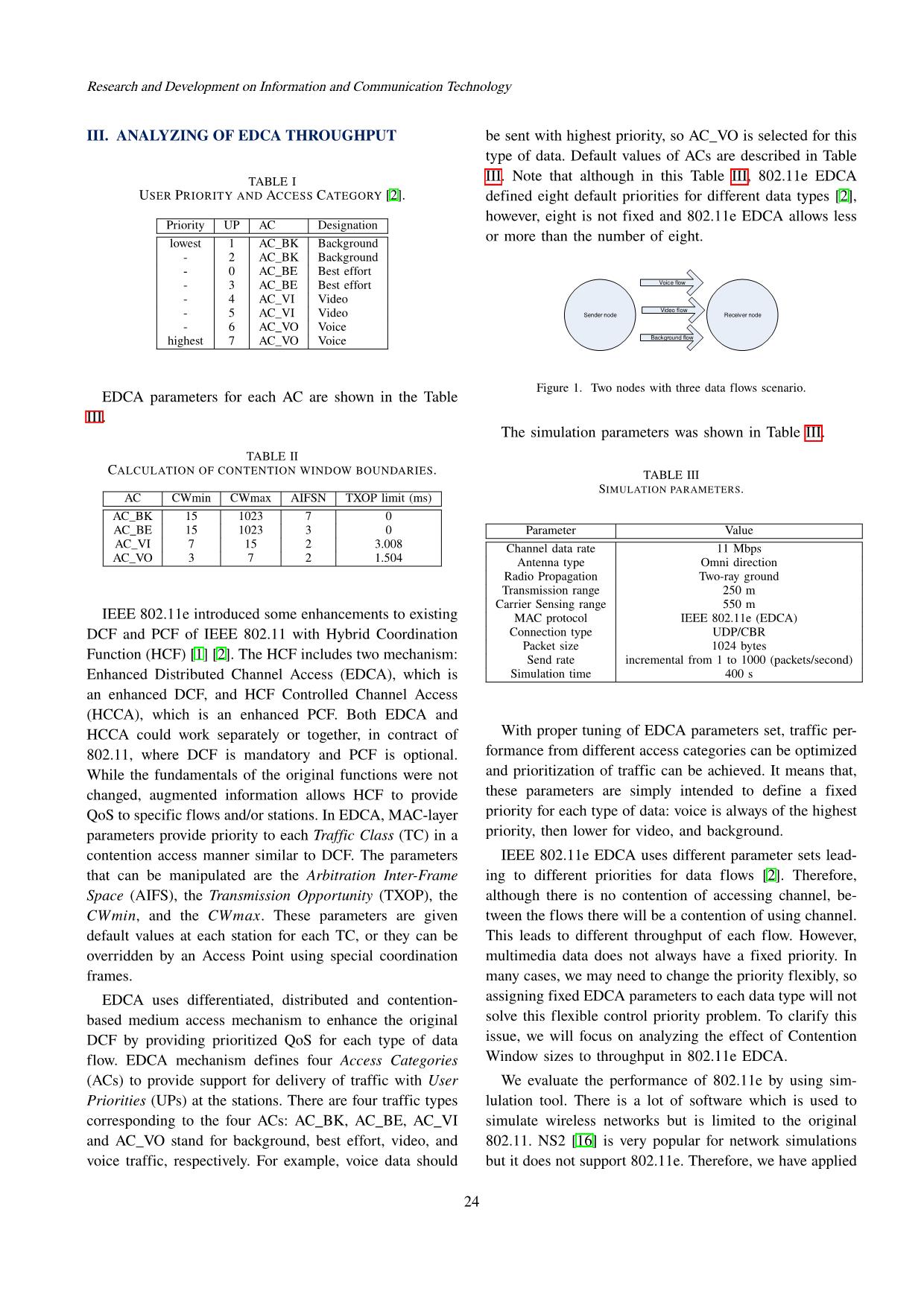
Trang 3
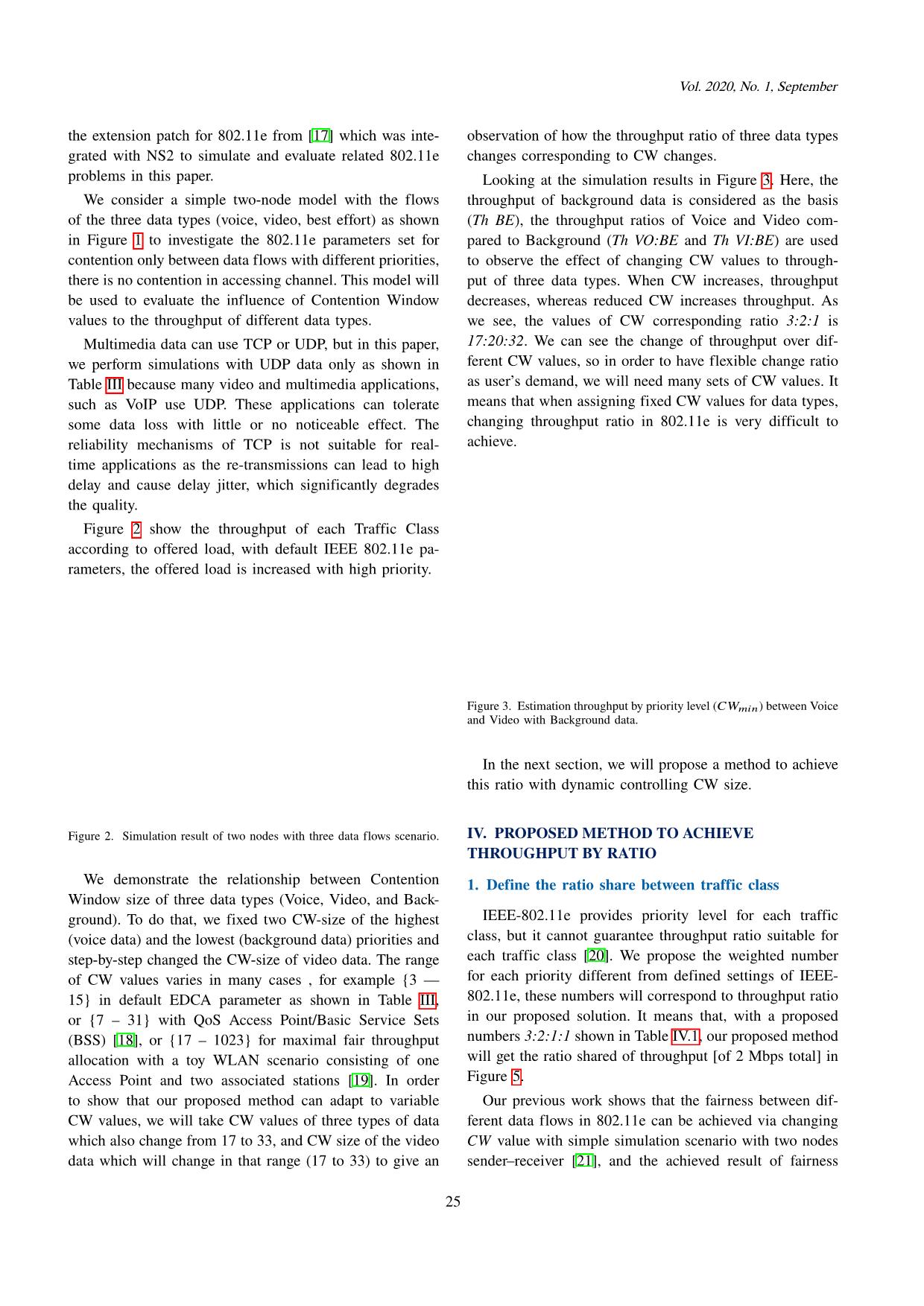
Trang 4
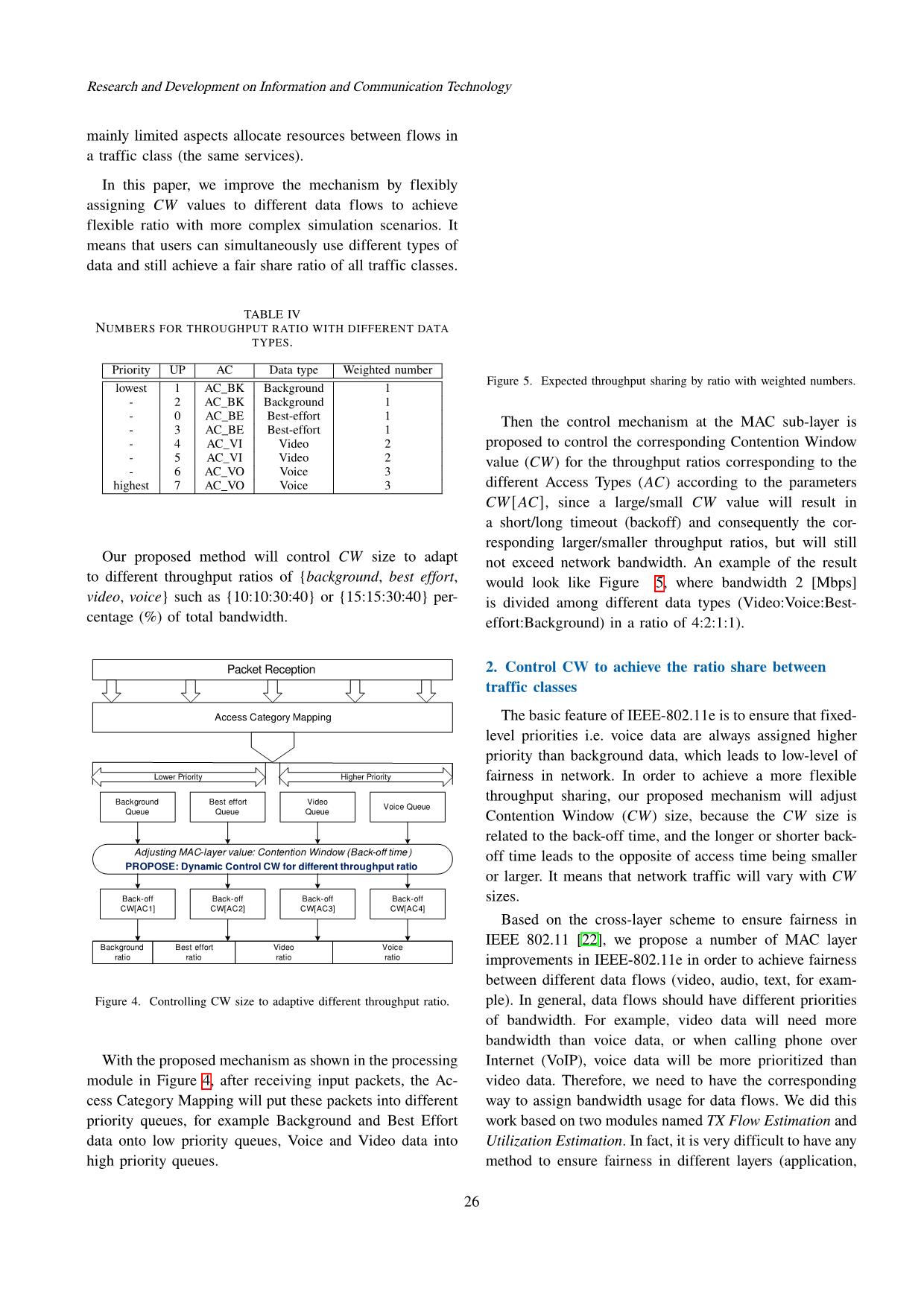
Trang 5
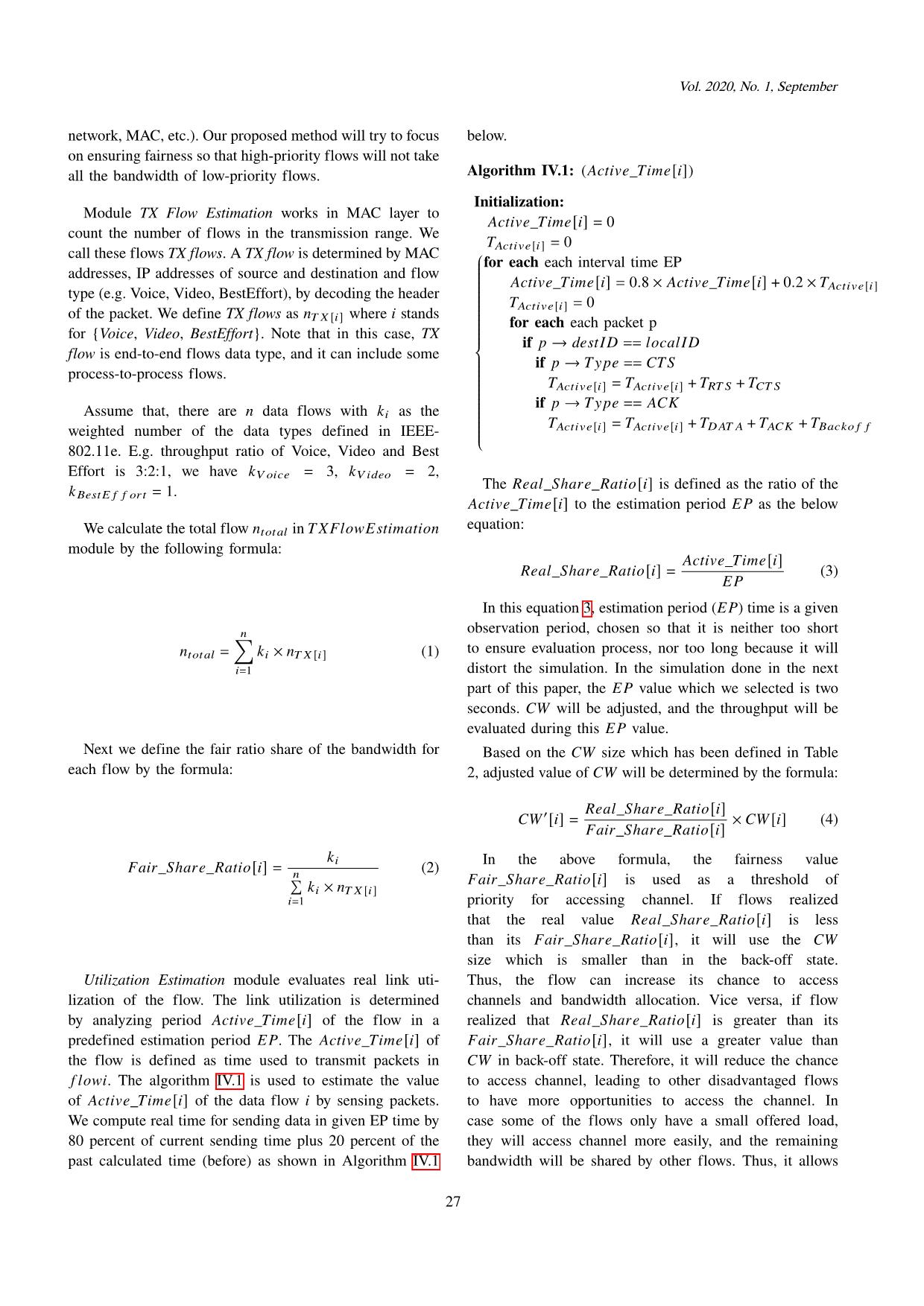
Trang 6
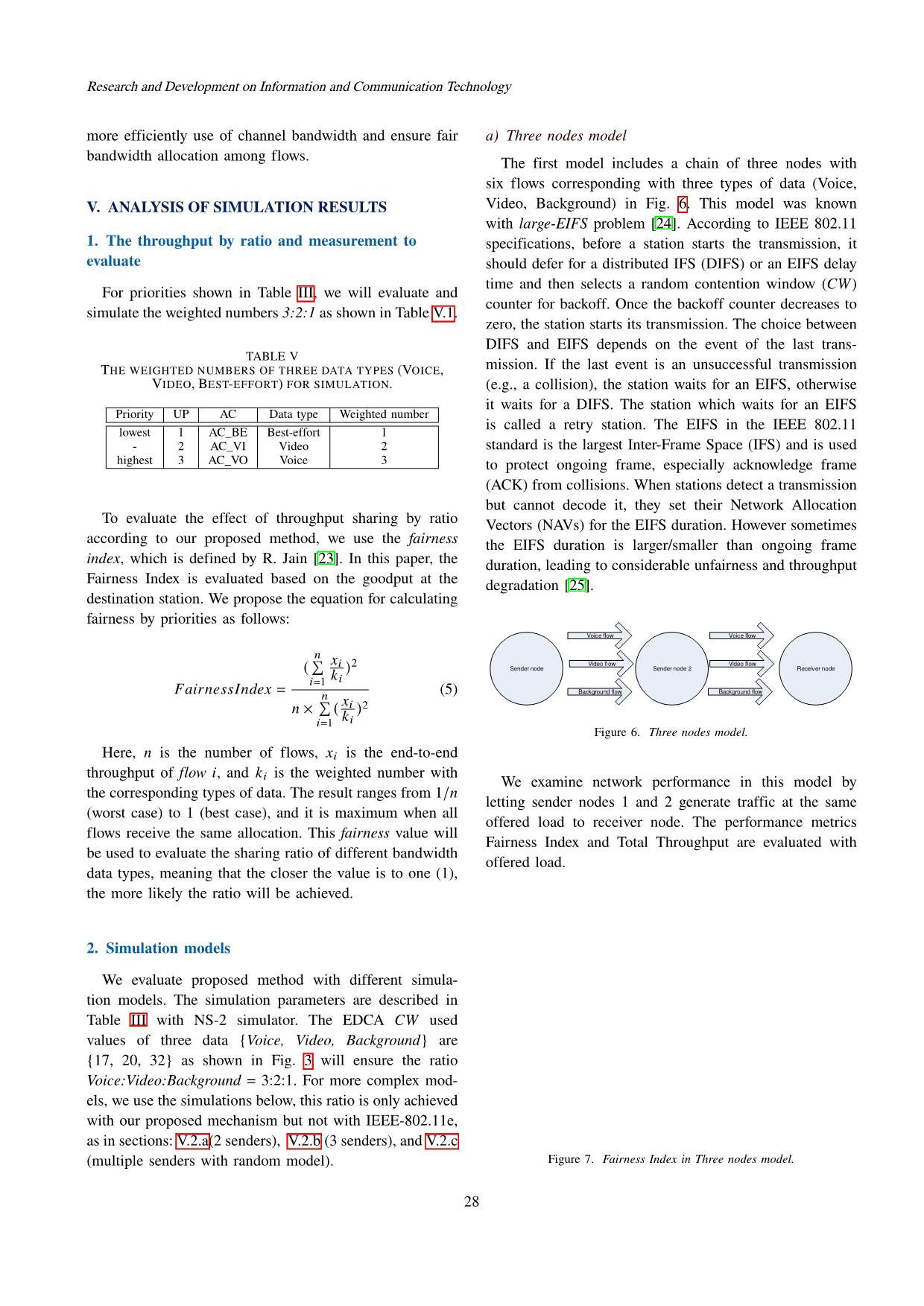
Trang 7
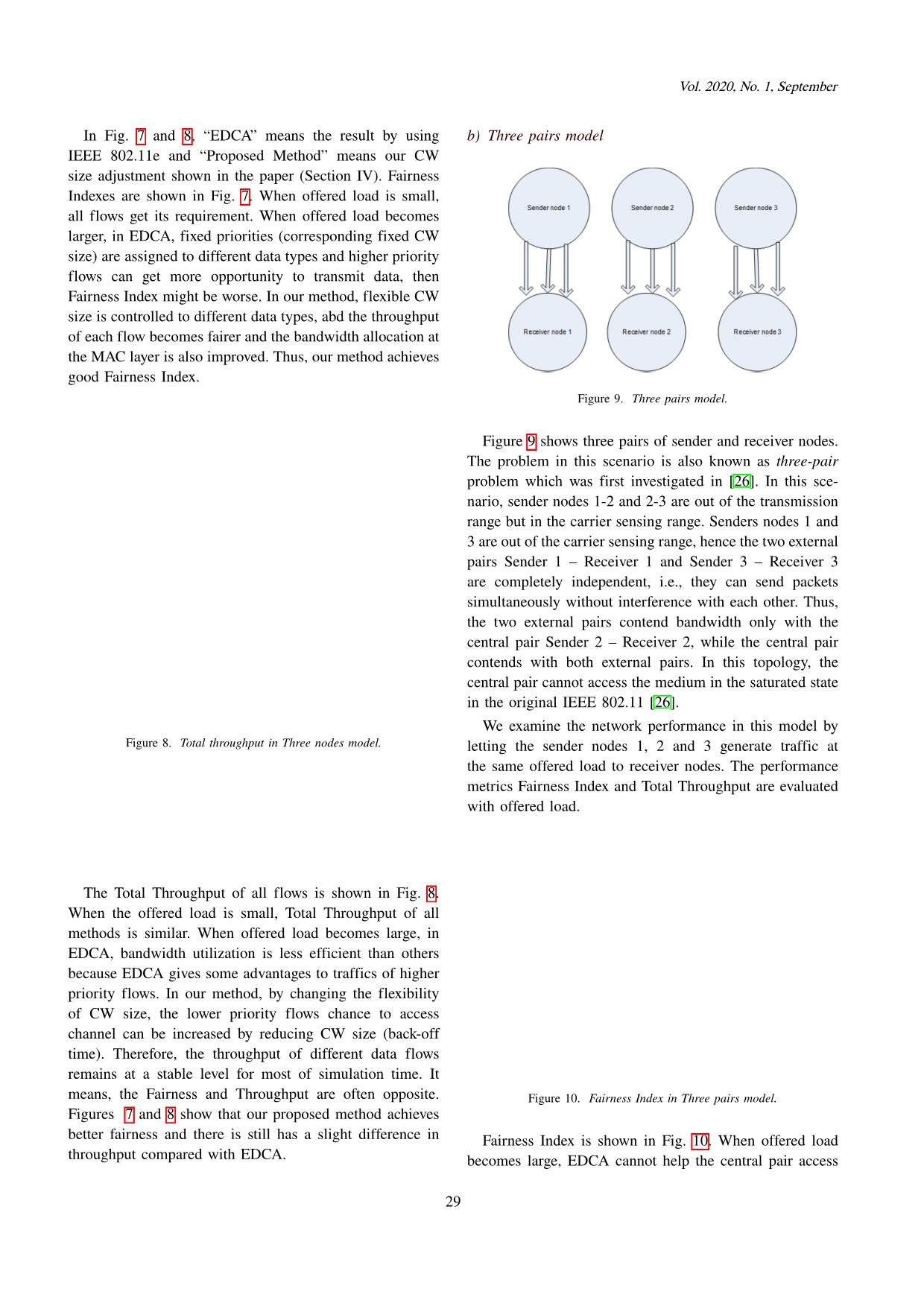
Trang 8
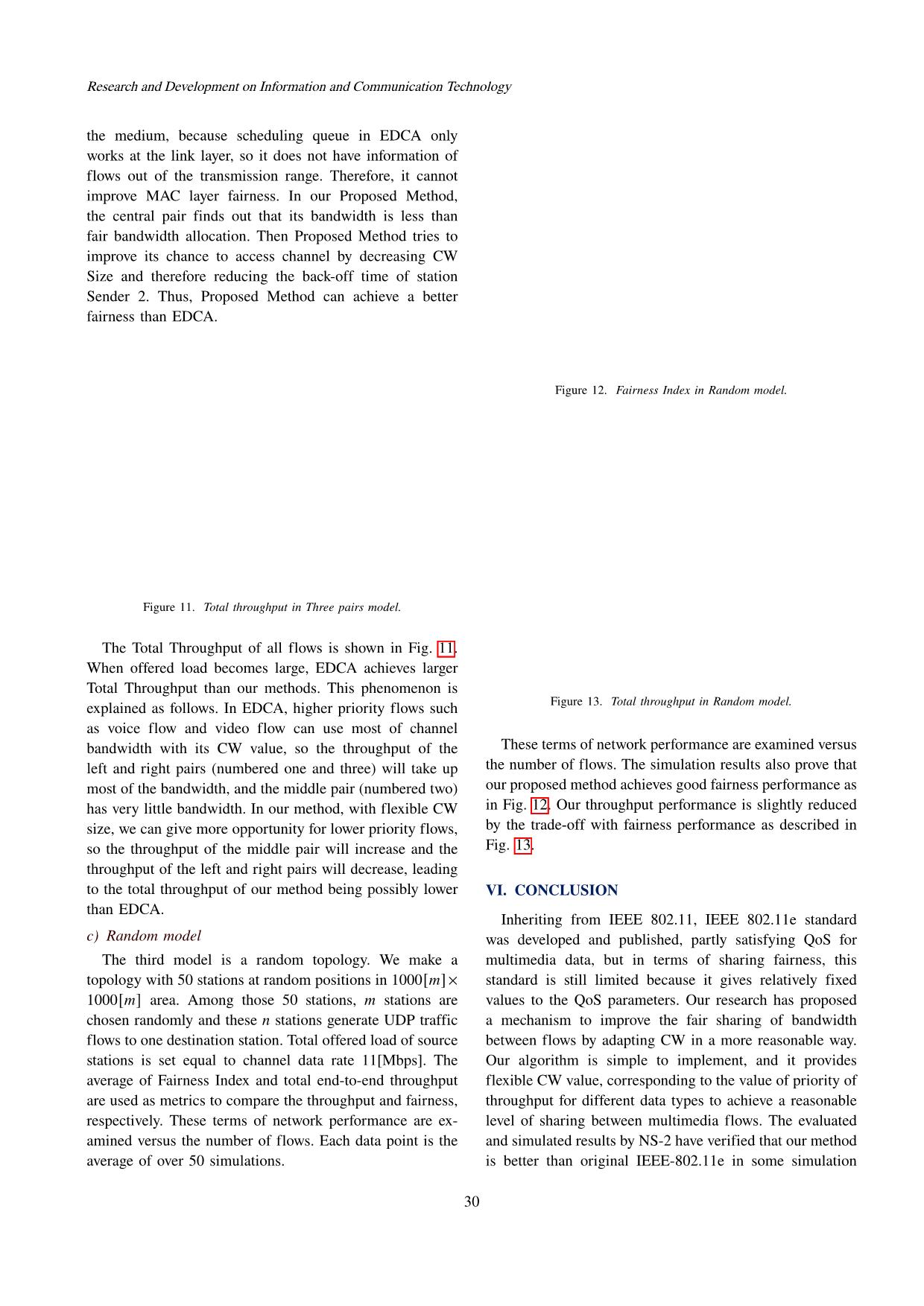
Trang 9
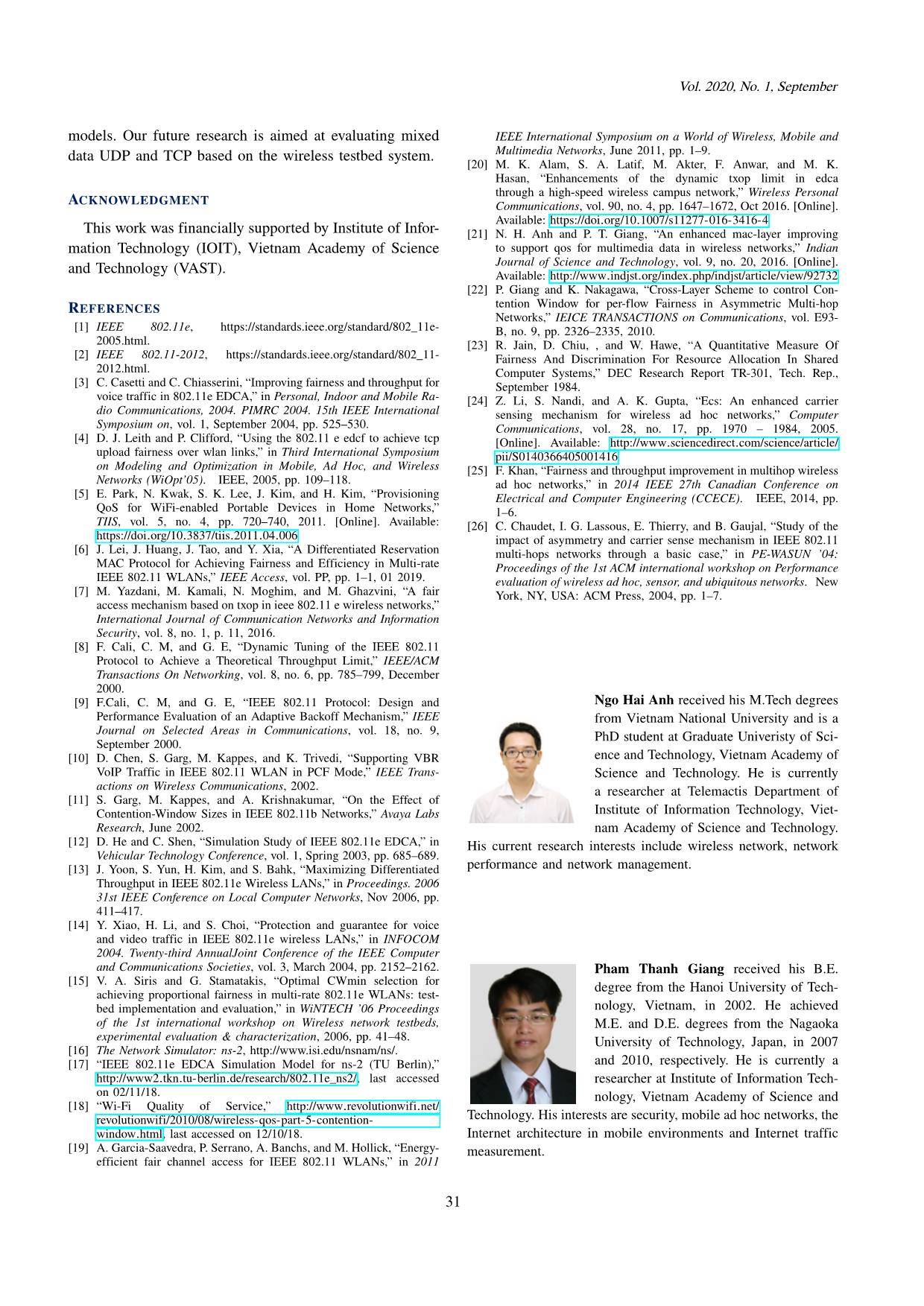
Trang 10
Bạn đang xem tài liệu "Controlling contention window to ensure QoS for multimedia data in wireless network", để tải tài liệu gốc về máy hãy click vào nút Download ở trên
Tóm tắt nội dung tài liệu: Controlling contention window to ensure QoS for multimedia data in wireless network
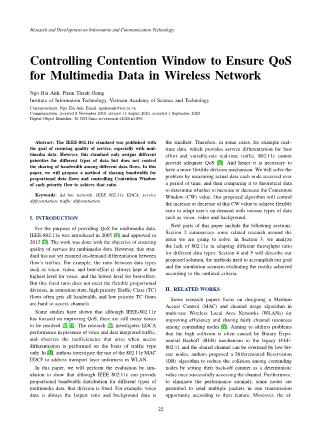
value will
be used to evaluate the sharing ratio of different bandwidth
data types, meaning that the closer the value is to one (1),
the more likely the ratio will be achieved.
2. Simulation models
We evaluate proposed method with different simula-
tion models. The simulation parameters are described in
Table III with NS-2 simulator. The EDCA 𝐶𝑊 used
values of three data {Voice, Video, Background} are
{17, 20, 32} as shown in Fig. 3 will ensure the ratio
Voice:Video:Background = 3:2:1. For more complex mod-
els, we use the simulations below, this ratio is only achieved
with our proposed mechanism but not with IEEE-802.11e,
as in sections: V.2.a(2 senders), V.2.b (3 senders), and V.2.c
(multiple senders with random model).
a) Three nodes model
The first model includes a chain of three nodes with
six flows corresponding with three types of data (Voice,
Video, Background) in Fig. 6. This model was known
with large-EIFS problem [24]. According to IEEE 802.11
specifications, before a station starts the transmission, it
should defer for a distributed IFS (DIFS) or an EIFS delay
time and then selects a random contention window (𝐶𝑊)
counter for backoff. Once the backoff counter decreases to
zero, the station starts its transmission. The choice between
DIFS and EIFS depends on the event of the last trans-
mission. If the last event is an unsuccessful transmission
(e.g., a collision), the station waits for an EIFS, otherwise
it waits for a DIFS. The station which waits for an EIFS
is called a retry station. The EIFS in the IEEE 802.11
standard is the largest Inter-Frame Space (IFS) and is used
to protect ongoing frame, especially acknowledge frame
(ACK) from collisions. When stations detect a transmission
but cannot decode it, they set their Network Allocation
Vectors (NAVs) for the EIFS duration. However sometimes
the EIFS duration is larger/smaller than ongoing frame
duration, leading to considerable unfairness and throughput
degradation [25].
Sender node Sender node 2 Receiver node
Voice flow
Video flow
Background flow
Voice flow
Video flow
Background flow
Figure 6. Three nodes model.
We examine network performance in this model by
letting sender nodes 1 and 2 generate traffic at the same
offered load to receiver node. The performance metrics
Fairness Index and Total Throughput are evaluated with
offered load.
Figure 7. Fairness Index in Three nodes model.
28
Vol. 2020, No. 1, September
In Fig. 7 and 8, “EDCA” means the result by using
IEEE 802.11e and “Proposed Method” means our CW
size adjustment shown in the paper (Section IV). Fairness
Indexes are shown in Fig. 7. When offered load is small,
all flows get its requirement. When offered load becomes
larger, in EDCA, fixed priorities (corresponding fixed CW
size) are assigned to different data types and higher priority
flows can get more opportunity to transmit data, then
Fairness Index might be worse. In our method, flexible CW
size is controlled to different data types, abd the throughput
of each flow becomes fairer and the bandwidth allocation at
the MAC layer is also improved. Thus, our method achieves
good Fairness Index.
Figure 8. Total throughput in Three nodes model.
The Total Throughput of all flows is shown in Fig. 8.
When the offered load is small, Total Throughput of all
methods is similar. When offered load becomes large, in
EDCA, bandwidth utilization is less efficient than others
because EDCA gives some advantages to traffics of higher
priority flows. In our method, by changing the flexibility
of CW size, the lower priority flows chance to access
channel can be increased by reducing CW size (back-off
time). Therefore, the throughput of different data flows
remains at a stable level for most of simulation time. It
means, the Fairness and Throughput are often opposite.
Figures 7 and 8 show that our proposed method achieves
better fairness and there is still has a slight difference in
throughput compared with EDCA.
b) Three pairs model
Figure 9. Three pairs model.
Figure 9 shows three pairs of sender and receiver nodes.
The problem in this scenario is also known as three-pair
problem which was first investigated in [26]. In this sce-
nario, sender nodes 1-2 and 2-3 are out of the transmission
range but in the carrier sensing range. Senders nodes 1 and
3 are out of the carrier sensing range, hence the two external
pairs Sender 1 – Receiver 1 and Sender 3 – Receiver 3
are completely independent, i.e., they can send packets
simultaneously without interference with each other. Thus,
the two external pairs contend bandwidth only with the
central pair Sender 2 – Receiver 2, while the central pair
contends with both external pairs. In this topology, the
central pair cannot access the medium in the saturated state
in the original IEEE 802.11 [26].
We examine the network performance in this model by
letting the sender nodes 1, 2 and 3 generate traffic at
the same offered load to receiver nodes. The performance
metrics Fairness Index and Total Throughput are evaluated
with offered load.
Figure 10. Fairness Index in Three pairs model.
Fairness Index is shown in Fig. 10. When offered load
becomes large, EDCA cannot help the central pair access
29
Research and Development on Information and Communication Technology
the medium, because scheduling queue in EDCA only
works at the link layer, so it does not have information of
flows out of the transmission range. Therefore, it cannot
improve MAC layer fairness. In our Proposed Method,
the central pair finds out that its bandwidth is less than
fair bandwidth allocation. Then Proposed Method tries to
improve its chance to access channel by decreasing CW
Size and therefore reducing the back-off time of station
Sender 2. Thus, Proposed Method can achieve a better
fairness than EDCA.
Figure 11. Total throughput in Three pairs model.
The Total Throughput of all flows is shown in Fig. 11.
When offered load becomes large, EDCA achieves larger
Total Throughput than our methods. This phenomenon is
explained as follows. In EDCA, higher priority flows such
as voice flow and video flow can use most of channel
bandwidth with its CW value, so the throughput of the
left and right pairs (numbered one and three) will take up
most of the bandwidth, and the middle pair (numbered two)
has very little bandwidth. In our method, with flexible CW
size, we can give more opportunity for lower priority flows,
so the throughput of the middle pair will increase and the
throughput of the left and right pairs will decrease, leading
to the total throughput of our method being possibly lower
than EDCA.
c) Random model
The third model is a random topology. We make a
topology with 50 stations at random positions in 1000[𝑚]×
1000[𝑚] area. Among those 50 stations, 𝑚 stations are
chosen randomly and these 𝑛 stations generate UDP traffic
flows to one destination station. Total offered load of source
stations is set equal to channel data rate 11[Mbps]. The
average of Fairness Index and total end-to-end throughput
are used as metrics to compare the throughput and fairness,
respectively. These terms of network performance are ex-
amined versus the number of flows. Each data point is the
average of over 50 simulations.
Figure 12. Fairness Index in Random model.
Figure 13. Total throughput in Random model.
These terms of network performance are examined versus
the number of flows. The simulation results also prove that
our proposed method achieves good fairness performance as
in Fig. 12. Our throughput performance is slightly reduced
by the trade-off with fairness performance as described in
Fig. 13.
VI. CONCLUSION
Inheriting from IEEE 802.11, IEEE 802.11e standard
was developed and published, partly satisfying QoS for
multimedia data, but in terms of sharing fairness, this
standard is still limited because it gives relatively fixed
values to the QoS parameters. Our research has proposed
a mechanism to improve the fair sharing of bandwidth
between flows by adapting CW in a more reasonable way.
Our algorithm is simple to implement, and it provides
flexible CW value, corresponding to the value of priority of
throughput for different data types to achieve a reasonable
level of sharing between multimedia flows. The evaluated
and simulated results by NS-2 have verified that our method
is better than original IEEE-802.11e in some simulation
30
Vol. 2020, No. 1, September
models. Our future research is aimed at evaluating mixed
data UDP and TCP based on the wireless testbed system.
ACKNOWLEDGMENT
This work was financially supported by Institute of Infor-
mation Technology (IOIT), Vietnam Academy of Science
and Technology (VAST).
REFERENCES
[1] IEEE 802.11e, https://standards.ieee.org/standard/802_11e-
2005.html.
[2] IEEE 802.11-2012, https://standards.ieee.org/standard/802_11-
2012.html.
[3] C. Casetti and C. Chiasserini, “Improving fairness and throughput for
voice traffic in 802.11e EDCA,” in Personal, Indoor and Mobile Ra-
dio Communications, 2004. PIMRC 2004. 15th IEEE International
Symposium on, vol. 1, September 2004, pp. 525–530.
[4] D. J. Leith and P. Clifford, “Using the 802.11 e edcf to achieve tcp
upload fairness over wlan links,” in Third International Symposium
on Modeling and Optimization in Mobile, Ad Hoc, and Wireless
Networks (WiOpt’05). IEEE, 2005, pp. 109–118.
[5] E. Park, N. Kwak, S. K. Lee, J. Kim, and H. Kim, “Provisioning
QoS for WiFi-enabled Portable Devices in Home Networks,”
TIIS, vol. 5, no. 4, pp. 720–740, 2011. [Online]. Available:
https://doi.org/10.3837/tiis.2011.04.006
[6] J. Lei, J. Huang, J. Tao, and Y. Xia, “A Differentiated Reservation
MAC Protocol for Achieving Fairness and Efficiency in Multi-rate
IEEE 802.11 WLANs,” IEEE Access, vol. PP, pp. 1–1, 01 2019.
[7] M. Yazdani, M. Kamali, N. Moghim, and M. Ghazvini, “A fair
access mechanism based on txop in ieee 802.11 e wireless networks,”
International Journal of Communication Networks and Information
Security, vol. 8, no. 1, p. 11, 2016.
[8] F. Cali, C. M, and G. E, “Dynamic Tuning of the IEEE 802.11
Protocol to Achieve a Theoretical Throughput Limit,” IEEE/ACM
Transactions On Networking, vol. 8, no. 6, pp. 785–799, December
2000.
[9] F.Cali, C. M, and G. E, “IEEE 802.11 Protocol: Design and
Performance Evaluation of an Adaptive Backoff Mechanism,” IEEE
Journal on Selected Areas in Communications, vol. 18, no. 9,
September 2000.
[10] D. Chen, S. Garg, M. Kappes, and K. Trivedi, “Supporting VBR
VoIP Traffic in IEEE 802.11 WLAN in PCF Mode,” IEEE Trans-
actions on Wireless Communications, 2002.
[11] S. Garg, M. Kappes, and A. Krishnakumar, “On the Effect of
Contention-Window Sizes in IEEE 802.11b Networks,” Avaya Labs
Research, June 2002.
[12] D. He and C. Shen, “Simulation Study of IEEE 802.11e EDCA,” in
Vehicular Technology Conference, vol. 1, Spring 2003, pp. 685–689.
[13] J. Yoon, S. Yun, H. Kim, and S. Bahk, “Maximizing Differentiated
Throughput in IEEE 802.11e Wireless LANs,” in Proceedings. 2006
31st IEEE Conference on Local Computer Networks, Nov 2006, pp.
411–417.
[14] Y. Xiao, H. Li, and S. Choi, “Protection and guarantee for voice
and video traffic in IEEE 802.11e wireless LANs,” in INFOCOM
2004. Twenty-third AnnualJoint Conference of the IEEE Computer
and Communications Societies, vol. 3, March 2004, pp. 2152–2162.
[15] V. A. Siris and G. Stamatakis, “Optimal CWmin selection for
achieving proportional fairness in multi-rate 802.11e WLANs: test-
bed implementation and evaluation,” in WiNTECH ’06 Proceedings
of the 1st international workshop on Wireless network testbeds,
experimental evaluation & characterization, 2006, pp. 41–48.
[16] The Network Simulator: ns-2,
[17] “IEEE 802.11e EDCA Simulation Model for ns-2 (TU Berlin),”
last accessed
on 02/11/18.
[18] “Wi-Fi Quality of Service,”
revolutionwifi/2010/08/wireless-qos-part-5-contention-
window.html, last accessed on 12/10/18.
[19] A. Garcia-Saavedra, P. Serrano, A. Banchs, and M. Hollick, “Energy-
efficient fair channel access for IEEE 802.11 WLANs,” in 2011
IEEE International Symposium on a World of Wireless, Mobile and
Multimedia Networks, June 2011, pp. 1–9.
[20] M. K. Alam, S. A. Latif, M. Akter, F. Anwar, and M. K.
Hasan, “Enhancements of the dynamic txop limit in edca
through a high-speed wireless campus network,” Wireless Personal
Communications, vol. 90, no. 4, pp. 1647–1672, Oct 2016. [Online].
Available: https://doi.org/10.1007/s11277-016-3416-4
[21] N. H. Anh and P. T. Giang, “An enhanced mac-layer improving
to support qos for multimedia data in wireless networks,” Indian
Journal of Science and Technology, vol. 9, no. 20, 2016. [Online].
Available:
[22] P. Giang and K. Nakagawa, “Cross-Layer Scheme to control Con-
tention Window for per-flow Fairness in Asymmetric Multi-hop
Networks,” IEICE TRANSACTIONS on Communications, vol. E93-
B, no. 9, pp. 2326–2335, 2010.
[23] R. Jain, D. Chiu, , and W. Hawe, “A Quantitative Measure Of
Fairness And Discrimination For Resource Allocation In Shared
Computer Systems,” DEC Research Report TR-301, Tech. Rep.,
September 1984.
[24] Z. Li, S. Nandi, and A. K. Gupta, “Ecs: An enhanced carrier
sensing mechanism for wireless ad hoc networks,” Computer
Communications, vol. 28, no. 17, pp. 1970 – 1984, 2005.
[Online]. Available:
pii/S0140366405001416
[25] F. Khan, “Fairness and throughput improvement in multihop wireless
ad hoc networks,” in 2014 IEEE 27th Canadian Conference on
Electrical and Computer Engineering (CCECE). IEEE, 2014, pp.
1–6.
[26] C. Chaudet, I. G. Lassous, E. Thierry, and B. Gaujal, “Study of the
impact of asymmetry and carrier sense mechanism in IEEE 802.11
multi-hops networks through a basic case,” in PE-WASUN ’04:
Proceedings of the 1st ACM international workshop on Performance
evaluation of wireless ad hoc, sensor, and ubiquitous networks. New
York, NY, USA: ACM Press, 2004, pp. 1–7.
Ngo Hai Anh received his M.Tech degrees
from Vietnam National University and is a
PhD student at Graduate Univeristy of Sci-
ence and Technology, Vietnam Academy of
Science and Technology. He is currently
a researcher at Telemactis Department of
Institute of Information Technology, Viet-
nam Academy of Science and Technology.
His current research interests include wireless network, network
performance and network management.
Pham Thanh Giang received his B.E.
degree from the Hanoi University of Tech-
nology, Vietnam, in 2002. He achieved
M.E. and D.E. degrees from the Nagaoka
University of Technology, Japan, in 2007
and 2010, respectively. He is currently a
researcher at Institute of Information Tech-
nology, Vietnam Academy of Science and
Technology. His interests are security, mobile ad hoc networks, the
Internet architecture in mobile environments and Internet traffic
measurement.
31
File đính kèm:
 controlling_contention_window_to_ensure_qos_for_multimedia_d.pdf
controlling_contention_window_to_ensure_qos_for_multimedia_d.pdf

